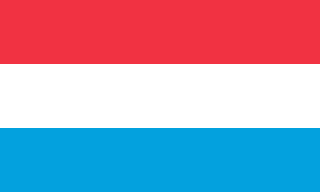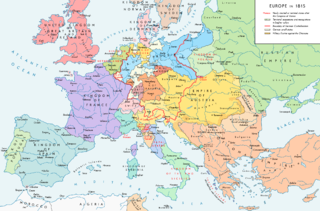
Luxembourgish, Luxemburgish or Letzeburgesch is a West Germanic language that is spoken mainly in Luxembourg. About 390,000 people speak Luxembourgish worldwide.
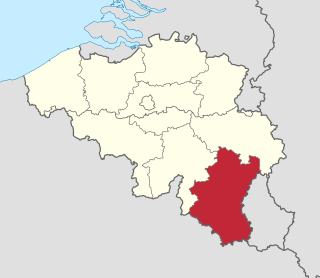
Luxembourg, also called Belgian Luxembourg, is the southernmost province of Wallonia and of Belgium. It borders on the country of Luxembourg, France, and the Belgian provinces of Namur and Liège. Its capital is Arlon, in the south-east of the province.
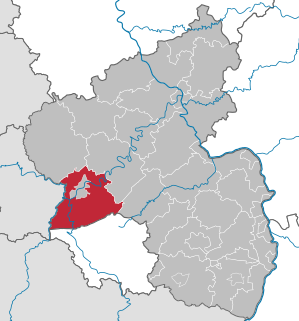
Trier-Saarburg is a district in the west of Rhineland-Palatinate, Germany. Neighboring districts are Bitburg-Prüm, Bernkastel-Wittlich, Birkenfeld, Sankt Wendel (Saarland), and Merzig-Wadern (Saarland). To the west it borders Luxembourg. The district-free city Trier is completely surrounded by the district.

Hosingen is a small village and former commune in northern Luxembourg. On January 1, 2012, the commune merged with Consthum and Hoscheid communes to form Parc Hosingen commune.

Forêts[fɔ.ʁɛ] was a department of the French First Republic, and later the First French Empire, in present-day Belgium, Luxembourg, and Germany. Its name, meaning 'forests', comes from the Ardennes forests. It was formed on 24 October 1795, after the Southern Netherlands had been annexed by France on 1 October. Before the occupation, the territory was part of the Duchy of Luxembourg and the Duchy of Bouillon. Its capital was Luxembourg City.
The 12 cantons of the Grand Duchy of Luxembourg are areas of local government at the first level of Local administrative unit (LAU-1) in the European Union's Nomenclature of Territorial Units for Statistics for Eurostat purposes. They were subdivisions of the three Districts of Luxembourg until 2015, when the district level of government was abolished. The cantons are in turn subdivided into 102 communes.
The linguistic situation in Luxembourg is characterised by the practice and the recognition of three official languages: French, German, and the national language Luxembourgish, established in law in 1984. These three languages are also referred to as the three administrative languages.
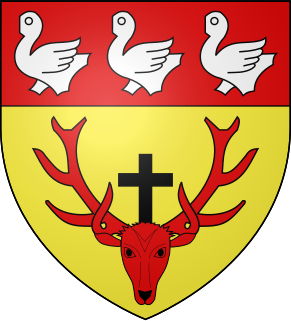
Munshausen is a village in northern Luxembourg, in the commune of Clervaux. Munshausen was the seat of its own commune until it was merged with Clervaux in 2009.

Dalheim is a commune and town in south-eastern Luxembourg. It is part of the canton of Remich, which is part of the district of Grevenmacher.
The Oesling or Ösling is a region covering the northern part of both the Grand Duchy of Luxembourg and Eifelkreis Bitburg-Prüm, within the greater Ardennes area that also covers parts of Belgium and France. The Oesling covers 32% of the territory of Luxembourg; to the south of the Oesling lies the Gutland, which covers the remaining 68% of the Grand Duchy as well as the southern part of the Eifelkreis Bitburg-Prüm.
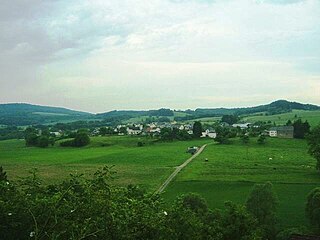
Bettel is a village in the commune of Tandel, in north-eastern Luxembourg. As of 2001, the village had a population of 207.

Echternacherbrück is a German municipality located on the Sauer river opposite the Luxembourgish town of Echternach. It is part of the district Bitburg-Prüm, in Rhineland-Palatinate. It includes the district of Fölkenbach. One of its main places of interest is the "Liboriuskapelle", a chapel located on the slopes of the Ferschweiler plateau.
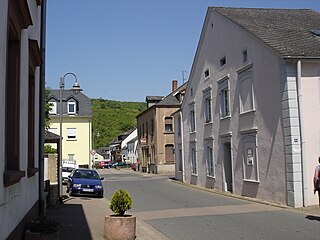
Langsur is a municipality in the Trier-Saarburg district, in Rhineland-Palatinate, Germany.

Sankt Julian is an Ortsgemeinde – a municipality belonging to a Verbandsgemeinde, a kind of collective municipality – in the Kusel district in Rhineland-Palatinate, Germany. It belongs to the Verbandsgemeinde Lauterecken-Wolfstein.

Dohm-Lammersdorf is an Ortsgemeinde – a municipality belonging to a Verbandsgemeinde, a kind of collective municipality – in the Vulkaneifel district in Rhineland-Palatinate, Germany. It belongs to the Verbandsgemeinde of Gerolstein, whose seat is in the like-named town.

The Battle of Vianden took place November 19, 1944 in the small town of Vianden in northern Luxembourg, and was one of the most important battles of the Luxembourg Resistance against Nazi Germany during World War II.
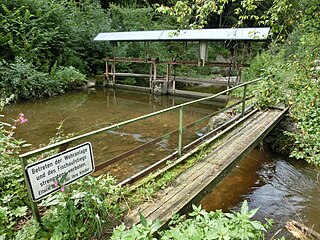
The Bollenbach is a roughly 7.8-kilometre-long stream in the German state of Baden-Württemberg within the county of Bodenseekreis. It is a right-hand tributary of the Argen.

The involvement of the Grand Duchy of Luxembourg in World War II began with its invasion by German forces on 10 May 1940 and lasted beyond its liberation by Allied forces in late 1944 and early 1945.







